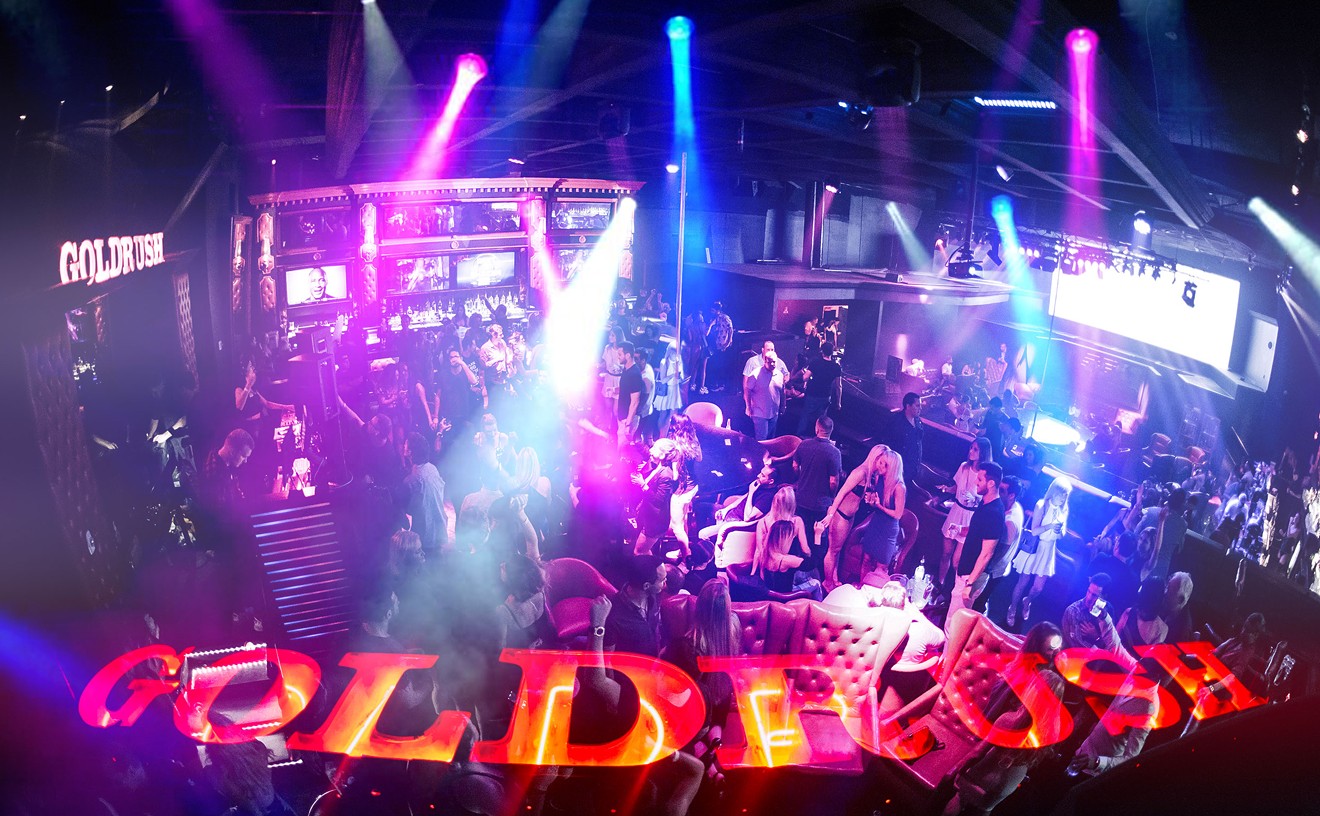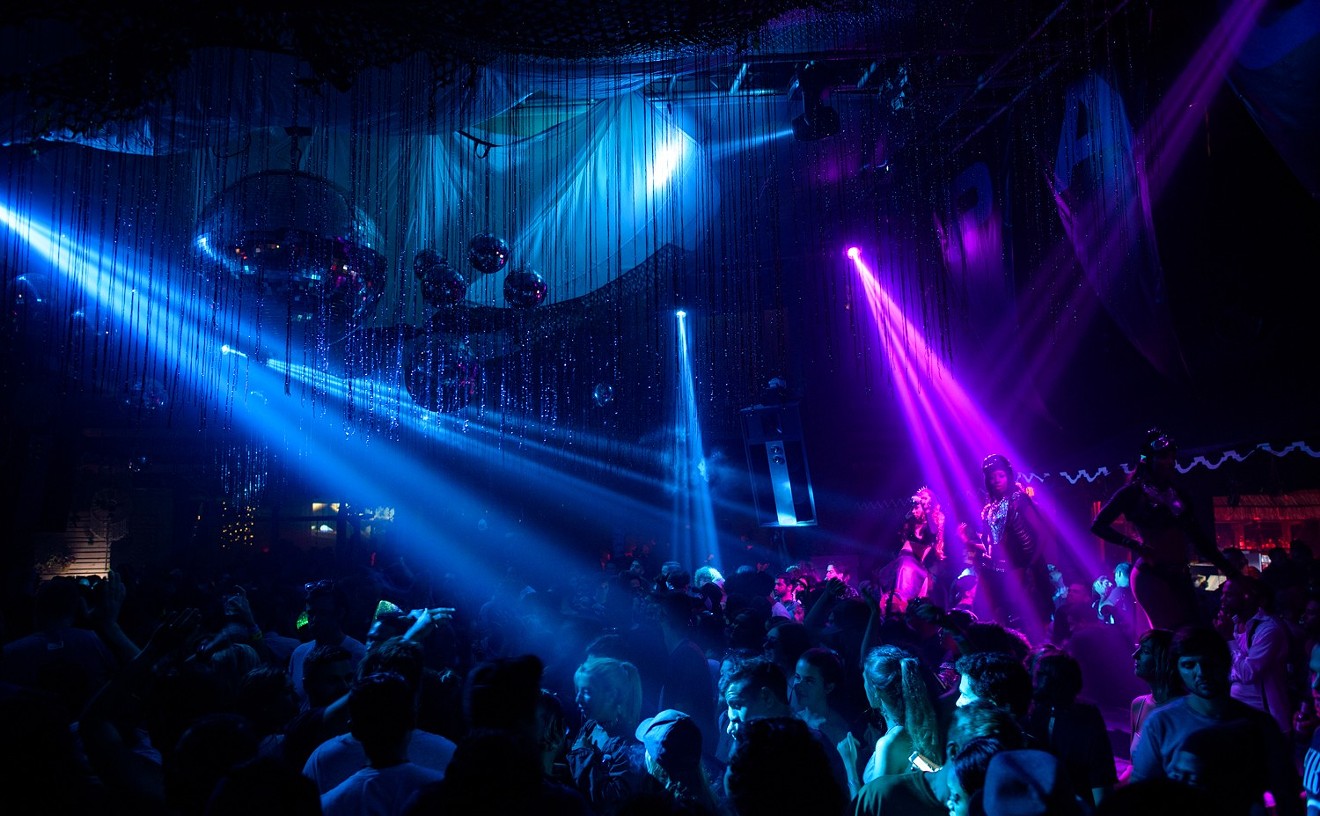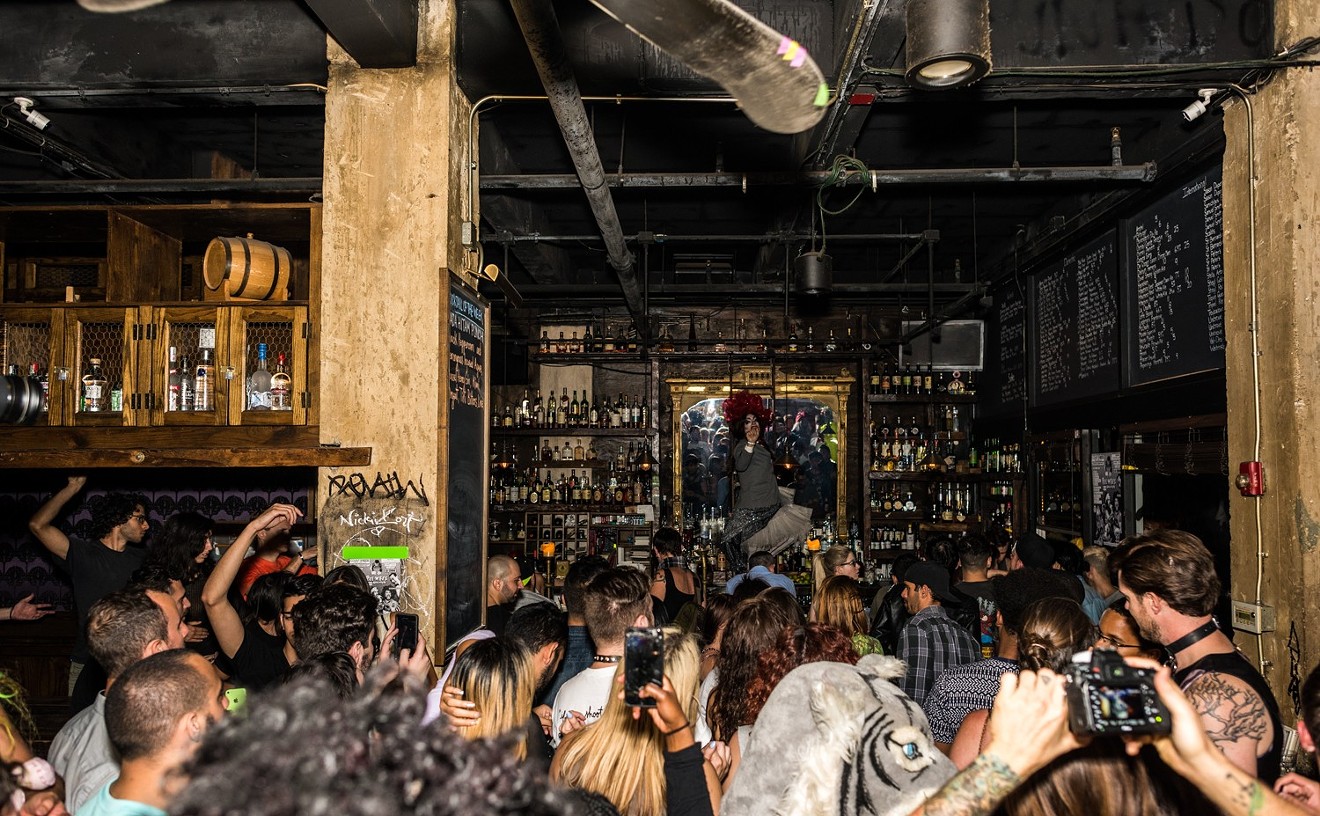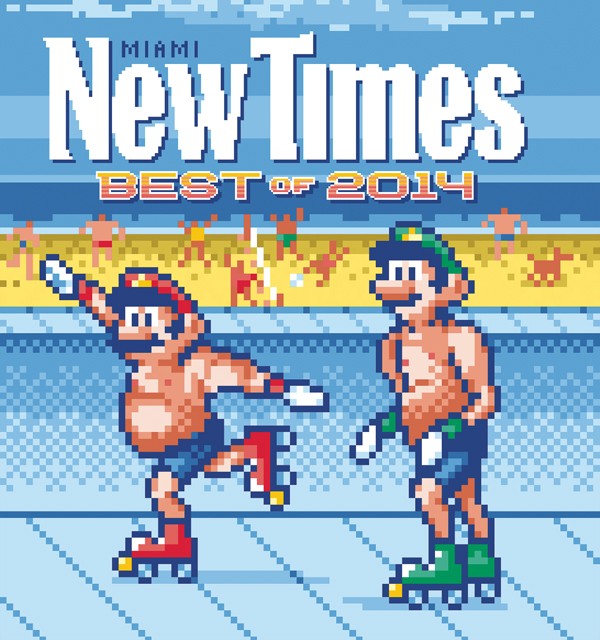"La casa de los artistas" is the slogan Kukaramakara uses to promote itself — and it's hard to argue with that self-assessment. In a city where people bow to the temple of the DJ, it's refreshing to see a live music club stake a claim on prime real estate in Brickell. However, live music alone doesn't make for a great Latin nightclub — most Latin clubs employ some kind of live instrumentation. Kukaramakara has set itself apart by doing it well for several years. The Colombian import started out on NE 11th Street in the old Studio A space. But when the posh South American crowds shied away from the dicey area, Kukaramakara made the best decision by packing up and moving to the city's South American expat epicenter of Brickell. Their live bands keep true to the target audience, employing mainly Colombian and Venezuelan musicians who are able to keep the Latin club vibe 100 percent authentic. Drinks are pricey here, but Miamians don't go to the club to eat and slam booze. Enjoy a moderately priced happy hour at one of the countless places nearby and then head to Kukaramakara for the real draw: shaking your ass to live jams until you can pronounce "merengue" like a native, rolled r and all.
Best Latin Club
Kukaramakara
- 8601 SW 124th Ave., Miami, 33183 Map
- 305-921-0333
- facebook.com/Kukaramakara-Miami-222639167765394
Best Rock Club
The Fillmore Miami Beach

The ghosts of Jackie Gleason and Jerry Garcia roam these halls. Opened in 1950 as the Miami Beach Auditorium, this 3,500-person theater was South Beach's chosen stage for Broadway-style musicals, world-class boxing exhibitions, and cameos by Frank Sinatra, Dean Martin, Bob Hope, and other cocktail-set celebrities. By 1964, it had become the official "home," as the façade proclaimed, "of The Jackie Gleason Show." And though the Great One's SoBe run lasted only six years, he earned a new moniker, Mr. Miami Beach, and the auditorium was permanently renamed in his honor. Four decades later, the ex-hippies finally moved into 1700 Washington Ave. and turned it into the southernmost outpost of Live Nation's Fillmore music venue franchise, named after the San Francisco original where Jerry Garcia and the Grateful Dead, Janis Joplin, Jefferson Airplane, and so many classic '60s rock bands became legends. Though almost constantly under threat of demolition as part of Miami Beach's ongoing pursuit of a 21st-century convention center, the Fillmore and all its history remains one of the only reasons that many of the world's biggest rock bands — from Vampire Weekend to Modest Mouse and Queens of the Stone Age — even bother visiting our city. And now with the sale of Churchill's Pub, the planned relocation of Tobacco Road, and the surprise closure of the Vagabond, Miami music fans and local opening bands such as Jacuzzi Boys need this storied old joint more than ever. As Jackie (dressed as leather-daddy Elvis) once said: "Noooooow, let's rock it and let's roll it, maaaaaan."
- 1700 Washington Ave., Miami Beach, 33139 Map
- 305-673-7300
- fillmoremb.com
Best Underground Club
Trade

Thanks to the Magic City's porous earth and position right at sea level, it's a scientific fact that Miami is one of the toughest places in America to get underground. There's a reason no one has a basement around here, folks. South Florida's musical underground, however, is a very different beast, and we're happy to report it's alive and well and ruled by benevolent overlords named Link/Miami Rebels. True EDM animals who've graduated from festival-ready anthems know that this party crew brings the best in progressive, deep, and techie house music that real fans want to hear. And their latest home base, which is not literally underground owing to the aforementioned geological restrictions, is called Trade. The SoBe spot is booked solid with rare and exciting acts across all groovy styles played on a luxurious dance floor under state-of-the-art lighting. With 7,500 square feet of space, Trade prides itself on being highly versatile, with heavy emphasis on a rich, full sound. From the bar to the system, the place was designed with a full-sensory dance experience in mind. It's not exactly Mammoth Caves, but for the 305 underground experience, Trade is the place to be.
- 1439 Washington Ave., Miami Beach, 33139 Map
- 305-531-6666
- trademia.com
Best Small Music Venue
Do Not Sit on the Furniture
The philosophy of this beat-freak hangout is right there in the name: If you're sitting, you're not dancing, and dancing is the whole point. That's why revelers looking for a grittier party experience in SoBe have been flocking to the latest dimly lit dancehall in town, affectionately referred to as Don't Sit. House heads have come to love the no-nonsense atmosphere in a space that's both charming and imaginative without being frilly and over-the-top. All right, the giant carnival ride light-up wheel dangling from the ceiling might be a lot, but when it's not blinking, you can hardly see the person grooving in front of you. The club has churned out great theme nights such as Rewind — a classic-house party — and killer acts like Francis Harris and DJ Behrouz. Combined with an underground feel that even Miami's hard-to-please fans can appreciate, there's little danger of anyone disobeying this club's driving mantra. Who would want to prop his feet up on the sofa anyway with beats like these rocking his brain?
- 423 16th St., Miami Beach, 33139 Map
- 510-550-5067
- donotsitonthefurniture.com
Best Live Music Venue
Mana Wynwood Production Village
Like the few remaining white warehouse walls just waiting for a tagger to slather on some spray-paint art, the Mana Wynwood Production Village is a blank slate. With a 39,000-square-foot sound stage and 100,000 of raw square footage, the village can host everything from major film shoots to fashion shows. But this year, the space has showed its true potential — as one of Miami's best spots for live music. In a short time, the location has seen Kendrick Lamar, Boy George, DJ Shadow, XXYYXX, Jamie xx, Darkside, and others entertain massive crowds in the heart of the Magic City's booming arts revival. Thanks to Mana's flexible space, organizers have transformed the village into a venue that can rival the Fillmore for production value, with great acoustics and creative stage designs. Let's face it — the city needs another midsize venue. Mana could help fill that void. Here's hoping this blank slate continues to get slathered in live music.
- 318 NW 23rd St., Miami, 33127 Map
- 305-573-0371
- manawynwood.com
Best Venue for Local Acts
The Nest
This Winter Music Conference pop-up-club-turned-permanent-party-spot is downtown Miami's home for, in the words of owner, promoter, and Massive Ideas founder Anders Scherberger, "weirder stuff that doesn't really fit into the normal category." And these days, the whole DWNTWN MIA crowd desperately needs a legit, late-night hangout that isn't just trying to re-create some hipster version of South Beach in a lightly renovated, heavily graffitied warehouse. For a time in the mid- to late 2000s, the NE 14th Street strip was the undisputed epicenter of mainland Miami's underground music and nightlife scene. There was I/O Lounge and PS14 and Pawn Shop and then the Vagabond, but they're all gone now. Yet in a certain way, the Nest is the offspring of that era, despite opening only this year. Now it would definitely be premature to predict any impending, all-out reincarnation of the spirit of 2006. But at least the cool kids and their favorite local acts still have someplace to party for free while dropping that Miami bass, hip-hop, and indie rock and laughing, "Screw the VIP."
- 62 NE 14th St., Miami, 33132 Map
- 786-766-2411
- www.thenestmia.com/
Best Strip Club
Wonderland

Lap dances make a man hungry. Fortunately, there exist splendorous houses of sensual pleasure like Wonderland, a strip club and dining establishment serving full-friction entertainment alongside chimichurri skirt steak with truffle mashed potatoes. While the more exotic aspects of a typical evening at this self-described "ultimate gentleman's club" are overseen by topless professionals with names like Tatyana, Charity, and Kristal, the never-closed kitchen is run by a former Novecento chef who has concocted an ambitious nudie-bar menu of steak-house-lite snacks and fancy American bistro fare. For the ideal five-course boobies-and-food experience, we suggest a $100, multisong sortie to the intimately lit, velvet-curtained private rooms, followed by the $12 shrimp tempura with soy sake sauce, a $10 post-appetizer martini, and the $17 tilapia fillet with chili-garlic spinach, all finished off with the flan de caramelo. Now that's what we call a happy ending. Wait, no. Not that kind.
- 7770 Biscayne Blvd., Miami, 33138 Map
- 305-631-2564
- goldrushcabaret.com
Best Dance Club
Club Space

Last year, Club Space founder Louis Puig sold his stake in the crown jewel of Miami's nightlife scene after 13 years of pushing the dance music mecca into the hearts and minds of booty-shaking people worldwide. How popular is Space? Popular enough that it has to open only once a week, on Saturday nights, to remain profitable. How many other nightclubs can get away with that? Now that new ownership has taken over Space, the best thing they've done so far is leave well enough alone. Except for some minor upgrades here and there, you'll encounter the same ol' familiar venue. This is still the place to go for people who don't want the party to ever end, dancing on the downtown terrace well past sunrise. It has learned to coexist with its new condominium neighbors to the east. But will it survive the encroachment from the planned Miami Worldcenter, the mega-shopping complex due to rise practically next door? Put your money on Space pulling through. In the event of a nuclear fallout, there are two things guaranteed to survive: cockroaches and Club Space.
- 34 NE 11th St., Miami, 33132 Map
- 786-616-6742
- clubspace.com
Best Nightlife Impresario
Emi Guerra

What were you doing at 22? Between graduating from college and looking for a job, you were probably getting high in your parents' spare bedroom while watching Grandma's Boy on cable. Emi Guerra, on the other hand, was cofounding one of Miami's most influential nightclubs, Space. But beyond that, the reason Guerra's name is synonymous with the best that dance music has to offer is because the man dreams big. Whether it's bringing Swedish House Mafia's Masquerade Motel to Miami for the first time or persuading Deadmau5 to give South Florida another shot by performing a free show at the Ice Palace, Guerra has the right booking agents and managers on speed dial. Sure, there have been hiccups in Guerra's career — UR1, an arts and music festival scheduled to take place during Art Basel, didn't pan out. But it says something about Guerra that he was able to dust himself off afterward and continue his envious nightlife career as if nothing happened. Innovators know there's no success without risk, and luckily for Dade County's dance fiends, Guerra's risks have single-handedly helped turn the Magic City into an EDM mecca.
- 34 NE 11th St., Miami, 33132 Map
- 786-616-6742
- clubspace.com
Best Jazz Night
Downtown Jazz at the Corner

Gone is the beloved Van Dyke Café, another victim of South Beach's rocketing property values, but thankfully the Magic City jazz that thrived upstairs at the Lincoln Road standby lives on downtown. Every Tuesday night, the Corner serves a delicious slice of syncopation. The atmosphere is much more subdued than the buzzed weekend crowds that make the Corner a go-to post-4 a.m. spot, but you aren't here to party, after all. Instead, sip a perfectly made craft cocktail and enjoy the music. Musicians change weekly, but there's never a bad set, which starts around 10:30 p.m. No matter who's playing, you'll never pay a cover.
- 1035 N. Miami Ave., Miami, 33136 Map
- 305-961-7887
- thecornermiami.com






